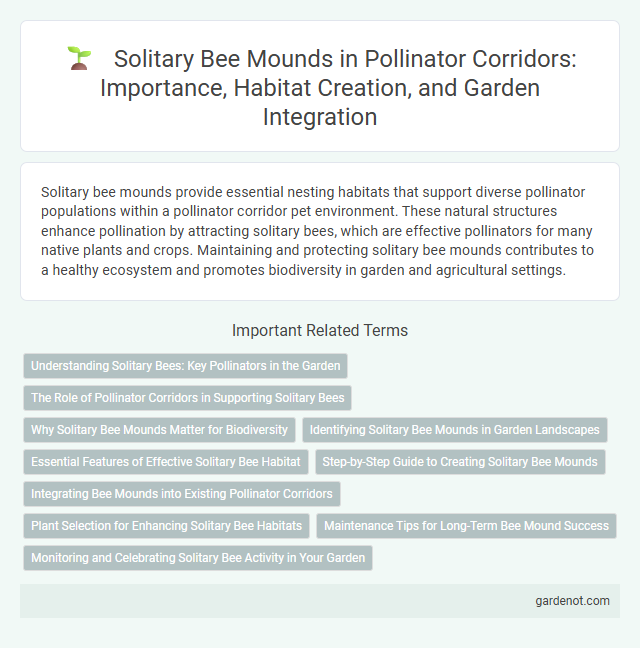Solitary bee mounds provide essential nesting habitats that support diverse pollinator populations within a pollinator corridor pet environment. These natural structures enhance pollination by attracting solitary bees, which are effective pollinators for many native plants and crops. Maintaining and protecting solitary bee mounds contributes to a healthy ecosystem and promotes biodiversity in garden and agricultural settings.
Understanding Solitary Bees: Key Pollinators in the Garden
Solitary bee mounds serve as crucial nesting sites that support the lifecycle of solitary bees, essential pollinators for diverse garden plants and crops. These bees, unlike social species, nest individually in soil or wood, enhancing pollination through their focused foraging behavior. Creating and preserving solitary bee mounds increases pollination efficiency, biodiversity, and garden yield by providing habitat tailored to the needs of these key pollinators.
The Role of Pollinator Corridors in Supporting Solitary Bees
Pollinator corridors provide essential habitat connectivity for solitary bee mounds by facilitating foraging and nesting opportunities across fragmented landscapes. These corridors increase floral diversity and nesting substrate availability, directly supporting solitary bee population resilience and reproductive success. Maintaining such corridors enhances ecosystem pollination services, vital for biodiversity and agricultural productivity.
Why Solitary Bee Mounds Matter for Biodiversity
Solitary bee mounds create essential habitats that support diverse pollinator populations, contributing to increased biodiversity and ecosystem resilience. These mounds provide nesting sites that enhance solitary bee reproduction, promoting genetic diversity and the pollination of a wide range of native plants. Protecting and restoring solitary bee mounds directly supports the health of pollinator corridors, critical for maintaining balanced ecosystems and food security.
Identifying Solitary Bee Mounds in Garden Landscapes
Solitary bee mounds are typically small, dome-shaped soil formations measuring 2 to 5 inches in diameter, often found in sunny, undisturbed garden areas with well-drained soil. Identifying these mounds involves observing fine entrance holes, usually about 3 to 5 millimeters wide, created by individual solitary bee species for nesting and provisioning offspring. Recognizing solitary bee mounds supports pollinator conservation by promoting habitat preservation within diverse garden landscapes.
Essential Features of Effective Solitary Bee Habitat
Effective solitary bee habitats feature well-drained soil mounds that provide suitable nesting sites for species like mining bees. These mounds require a diversity of native flowering plants nearby to supply ample pollen and nectar throughout the active seasons. Proper sunlight exposure and minimal soil disturbance further enhance the suitability of these habitats for solitary bee reproduction and foraging.
Step-by-Step Guide to Creating Solitary Bee Mounds
Creating solitary bee mounds requires selecting a sunny, well-drained location with sandy or loamy soil to mimic natural nesting habitats. Begin by clearing the area of debris, then shape small mounds approximately 12 inches in diameter and 6 inches high, ensuring loose soil for easy burrowing. Maintain the mounds by avoiding disturbance, watering during dry spells, and refraining from pesticide use to support solitary bee populations effectively.
Integrating Bee Mounds into Existing Pollinator Corridors
Integrating solitary bee mounds into existing pollinator corridors enhances habitat diversity and provides vital nesting sites for native bee populations, boosting pollination efficiency and ecosystem resilience. These mounds support ground-nesting solitary bees like Andrena and Osmia, which contribute significantly to local biodiversity and crop pollination. Strategically placing bee mounds along corridors ensures connectivity between floral resources and nesting habitats, promoting sustained pollinator activity throughout the season.
Plant Selection for Enhancing Solitary Bee Habitats
Selecting native flowering plants with staggered bloom periods significantly enhances solitary bee mound habitats by providing continuous forage throughout the active seasons. Incorporating diverse plant species such as goldenrod, coneflowers, and wild bergamot supports various solitary bee species like Osmia and Andrena by offering essential nectar and pollen resources. Creating a habitat with sunny, well-drained soils alongside these targeted plantings optimizes solitary bee nesting success and population growth.
Maintenance Tips for Long-Term Bee Mound Success
Regularly remove invasive weeds and gently clear debris around the solitary bee mound to maintain optimal nesting conditions. Ensure the soil remains dry but not compacted by avoiding excessive watering, which supports healthy brood development. Implement seasonal checks for predators or disease signs to protect the bee population and enhance long-term mound viability.
Monitoring and Celebrating Solitary Bee Activity in Your Garden
Monitoring solitary bee mounds involves regular observation of entrance holes, bee emergence, and pollen collection patterns to assess population health and diversity. Installing motion-activated cameras or using simple visual surveys can help document solitary bee activity without disturbing their habitat. Celebrating solitary bee presence in your garden enhances pollination efficiency and encourages biodiversity, supporting a balanced ecosystem essential for crop production and native plant reproduction.
Solitary bee mound Infographic

 gardenot.com
gardenot.com